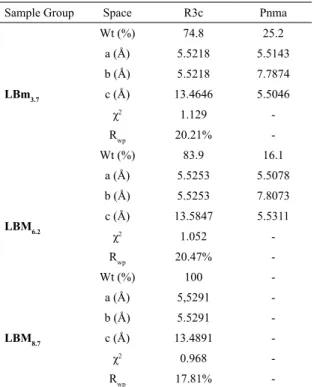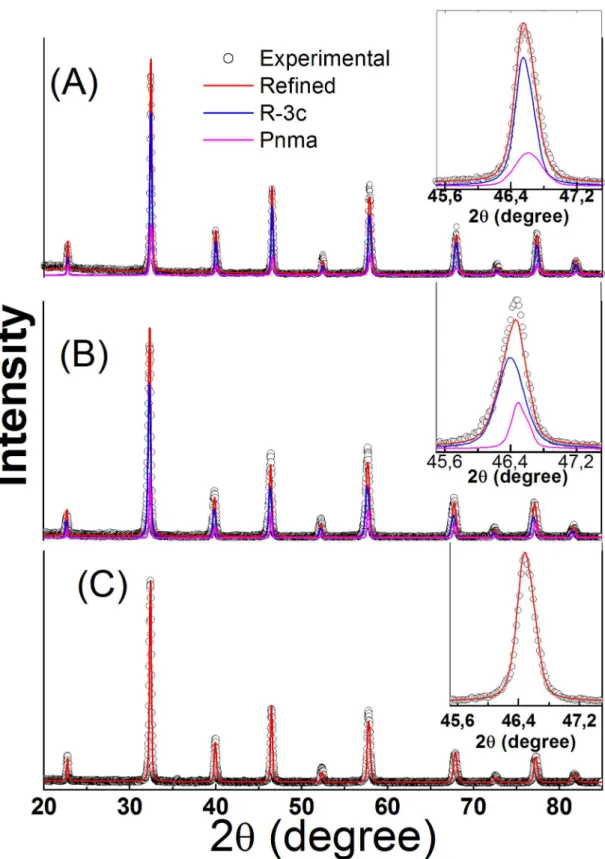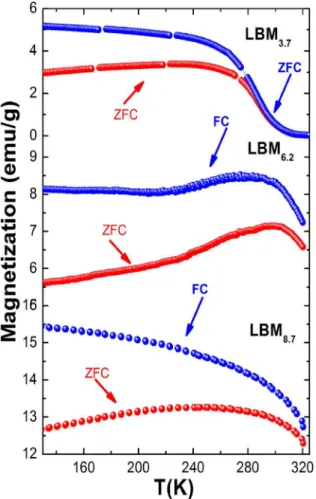Influence of Pellet Compaction Pressure on the Physical Properties of La
0.7Ba
0.3MnO
3Manganite
Cintia Raquel Duarte de Freitasa, Meirielle Marques de Góisa, Rodolfo Bezerra da Silvaa*,
José Alzamir Pereira da Costaa, João Maria Soaresa
Received: February 16, 2017; Revised: October 01, 2017; Accepted: November 10, 2017
Perovskite manganite La0.7Ba0.3MnO3, synthesized by ionic coordination reaction method (ICR)
was compacted into pellets under different compaction pressures (Pc) and sintered at a temperature of
1150°C for 10h under a flow of O2. X-ray diffraction (XRD) data reveal that the samples can present
simultaneously two phases - a rhombohedral structure with space group R3c and an orthorhombic structure with space group Pnma. Scanning electron microscopy (SEM) images show that, for this sintering
temperature, the particle size and shape can be modified depending on the compaction pressure (Pc).
Magnetization measurements show that the saturation magnetization and Curie temperature increase with Pc. The enhancement of the ferromagnetic properties of perovskite manganites La0.7Ba0.3MnO3 as a function of the compaction pressure is explained by an increase in the rhombohedral/orthorhombic
structure ratio caused by this effect.
Keywords: Reaction by ionic coordination (RCI), compaction pressure
*e-mail: rodolfo.bezerra.silva@gmail.com
1. Introduction
Perovskite-type RE1-xAExMnO3, with RE representing a rare earth and AE an alkaline earth ion (AE = Ca, Ba, Sr
and Pb), has attracted great scientific interest because of
its peculiar physical properties and potential technological applications such as magnetic recording, magnetic heating and switch control in hyperthermia treatment, refrigerating materials, and as a cathode in solid oxide fuel cells (SOFCs)1-6.
Its fundamental properties show a strong correlation between crystal structure and chemical composition, and it displays features such as electronic transport and magnetic properties. The LaMnO3compound is an A-type antiferromagnetic material with Neel temperature TN = 140 K, having an orthorhombic structure and space group Pnma, and at this stoichiometry the Mn element has valence (3+)5.
The partial substitution of the trivalent element (La3+) at
the A site by divalent elements leads these compounds to present valence mixing in the metal element at the B site of its ABO3 type structure. In this case, the manganese has valences (3+) and (4+), causing the existence of bonds of type Mn3+ - Mn3+ and Mn3+ - Mn4+. This valence mixture
is responsible for strengthening of effects such as colossal magnetoresistance (CMR) and the magnetocaloric effect
(MCE) in manganites6. The La
1-xBaxMnO3 compounds
have a high concentration of vacancies in both A (La/ Ba) and B (Mn) sites, which gives rise to large localized
distortions, influencing the physical properties of the
material7-11. It has been shown that in samples of type
La2/3Ba1/3MnO3 the crystal-structure parameters such as mean bond length <Mn - O> and the mean bond angle <Mn - O - Mn> are factors determining the properties of the manganites12,13. Usually this variation leads to an
increase in electron bandwidth that can strongly modify the Curie temperature and the metal-to-insulator transition temperature as well as decreasing the resistivity12,13. Reported
studies in the literature show that manganite properties such as insulator to metal transition temperature TIM, Curie temperature (TC), charge ordering (CO) and magnetization can have a strong dependence on an applied hydrostatic pressure13-17. Although several studies have been carried
out on manganites as a function of hydrostatic pressure,
we have not found any paper reporting studies on the effect
of compaction pressure on the physical properties of the pellet samples. The compaction pressure used to form the pellets before sintering can also be an important parameter
affecting the magnetic and electron transport properties of
manganites. Therefore, we decided to study the possible
effects on the structural and magnetic properties of the
manganite La0.7Ba0.3MnO3 synthesized by the chemical method of ionic coordination reaction (ICR), preparing pellets under compaction pressures of 3.7x102, 6.2x102
and 8.7x102 MPa. The crystal-structure and microstructural
parameters, average particle sizes, micro deformation, lattice parameters and some magnetic properties were
studied. We show that the compaction pressure modified
the crystalline perovskite structure, the values of lattice parameters and magnetic properties.
aDepartamento de Física, Universidade do Estado do Rio Grande do Norte, Mossoró RN, 59610-090,
2. Experimental
Perovskite La0.7Ba0.3MnO3 was synthesized by an ionic coordination reaction method18. For the synthesis we used
the nitrates La(NO3)3.9H2O, Ba(NO3)2, and Mn(NO3)3.4H2O, which were added to an aqueous solution of chitosan based polymer. The chitosan based solution was prepared by dissolving 5% citric acid in 500 ml of distilled water and then adding 2% chitosan, and maintained under magnetic
stirring for 24 h. After this period the solution was filtered
to remove excess chemicals. The La, Ba and Mn nitrates were added, under magnetic stirring, to the chitosan solution in the desired stoichiometry (0.7La:0.3Ba:1.0Mn). Once this new solution was homogenized, 10% by volume of glutaraldehyde was added. After 2 hours at room temperature the solution became gelled. The gel was thermally treated on a hot plate for 8 hours at an average temperature of 150 °C. The calcined powder was used to produce a set of three pellets using a 10 mm diameter cylindrical pelletizer with compaction pressures of 3.7x102, 6.2x102 and 8.7x102 MPa.
The pellets were sintered in a tubular furnace at a temperature
of 1150 °C for 10 hours in a flow of O2. The three sintered
samples were named LBM3.7, LBM6.2 and LBM8.7. X-ray
diffraction (XRD) patterns of these pellets were obtained using a Rigaku diffractometer, model Mini flex II with
Cu-Kα radiation, using a scan step size of 0.02° and scan speed of 1°/min. The average size of the crystallites and crystal structure were obtained by the Rietveld method using Maud software19,20. The morphologies were observed by scanning
electron microscopy (SEM), using a Tescan-MIRA3 LMU
microscope. Zero field cooled (ZFC) and field cooled (FC)
measurements of the magnetic hysteresis loops measurements were performed in a vibrating sample magnetometer (VSM).
For the ZFC magnetization curve, the sample is first cooled in a zero field from a high temperature down to a low temperature. Then the magnetic field is applied and the
magnetization as a function of temperature is measured in the warming process. The FC curve is obtained by cooling the sample to the low temperature in the same magnetic
field, then measuring magnetization versus temperature in
the warming process.
3. Results and Discussion
3.1. Structural Analysis (XRD) and (SEM)
X-ray diffraction (XRD) patterns for samples LBM3.7, LBM6.2
and LBM8.7are shown in Figure 1. The formation of crystalline phases of La0.7Ba0.3MnO3 perovskite is observed in the XRD patterns, but no other phase is observed within the resolution
of the X-ray diffraction. The Rietveld refinement data show
that samples LBM3.7 (figure 1(A)) and LBM6.2 (figure 1(B)) present two perovskite structures, a rhombohedral structure
with space group R3c and an orthorhombic structure with space group Pnma. Figure 1(C) shows that sample LBM8.7 only has the rhombohedral structure with space group R3c. Table 1 shows the crystalline parameters, obtained by
Rietveld refinements, for all samples. These data reveal that
the compaction pressure can be used to control the types of crystalline structure. The values of the a and c lattice
parameters obtained by Rietveld refinements for all samples
are very close to values already reported for bulk samples21.
The inserts in figures 1(A)-(B) show details of the (024) peak
for the rhombohedral structure and of the (040) and (202) peaks for the orthorhombic structure for samples LBM3.7 and LBM6.2, respectively. For sample LBM8.7, the insert in
figure 1(C) shows that peak at 2θ = 46.48° was refined only
as the rhombohedral crystalline structure.
Figure 2 shows images from scanning electron microscopy (SEM) for samples LBM3.7, LBM6.2 and LBM8.7, using
two magnifications. In figures 2(a)-(c) we show the SEM micrographs with magnifications of 304 - 306x, which show
the microstructure of the pellet surfaces.
Low porosity can be observed, indicating that the compaction process and heat treatment were enough to produce a relatively homogeneous sample surface.
Analyzing the images we see an indication that the pellet compaction pressure can be an important parameter
since it clearly modified the surfaces of the samples. Sample
LBM8.7, made with an applied pressure of 8.7x102 MPa,
shows a smoother surface, indicating a good sintering effect
on the material.
Table 1. Refined structural parameters of XRD: Weight wt, lattice
parameters a, b and c, weighted – profile Rwt and goodness of fit χ 2
for samples LBM3.7, LBM6.2 and LBM8.7.
Sample Group Space R3c Pnma
LBm3.7
Wt (%) 74.8 25.2
a (Å) 5.5218 5.5143
b (Å) 5.5218 7.7874
c (Å) 13.4646 5.5046
χ2 1.129
-Rwp 20.21%
-Wt (%) 83.9 16.1
LBM6.2
a (Å) 5.5253 5.5078
b (Å) 5.5253 7.8073
c (Å) 13.5847 5.5311
χ2 1.052
-Rwp 20.47%
-Wt (%) 100
-LBM8.7
a (Å) 5,5291
-b (Å) 5.5291
-c (Å) 13.4891
-χ2 0.968
-Figure 1. XRD patterns for pellet samples of LBM3.7, LBM6.2 and LBM8.7 calcined at 1150 °C/10h. The open points and lines are experimental
Figure 3. Magnetic hysteresis loop for the samples LBM3.7, LBM6.2
and LBM8.7 Measured at 10 K. The inset shows the saturation
magnetization (T = 10K ) in function of compaction pressure.
Figure 4. Field Cooled and Zero Field Cooled Magnetizations for
Samples LBM3.7, LBM6.2 and LBM8.7.
Figures 2 (d)-(f) show SEM images with magnification
of 30 kx for all the samples analyzed. We observe that sample LBM3.7 consists of crystallites with sizes ranging from 0.50 - 1.82 µm with a mean crystallite size of 1.11µm. For samples LBM6.2 and LBM8.7, the average diameters obtained directly
from the SEM pictures (figures 2(e)-(f)) were 126 nm and
108 nm, respectively.
We believe that this effect occurs in the synthesizing
process in which metallic ions of the nitrates are bound to
the chitosan chain. Due to the action of the glutaraldehyde,
this then forms a cross-linked chain agglomerate, trapping the metal ions in very narrow spaces. The applied pressure on the pre-calcined powder breaks down the agglomerates into smaller parts that will form the crystallites during the sintering process. We conclude that the increase of compaction pressure Pc decreases the average size of crystallites in the sintered samples. Thus, the larger the Pc value the smaller the particle sizes that make up the resulting La0.7Ba0.3MnO3
manganite. In addition, the effect of compaction pressure
causes a decrease in the unit cell volume V, which leads to a decrease in the <Mn - O> bond length and to an increase
in the <Mn - O - Mn> bond angles influencing the physical
properties of the material.
3.2 Magnetization Measurements
Figure 3 shows the magnetic hysteresis curves at a temperature of 10 K for samples LBM3.7, LBM6.2 and LBM8.7. From the curves we observe ferromagnetic (FM) behavior for all samples. Sample LBM3.7 has the lowest value of the saturation magnetization MS = 31 emu/g, while samples LBM6.2 and LBM8.7 exhibit MS values of 43 and 73 emu/g, respectively. The value of MS for sample LBM3.7 is very close to the value obtained by Kundu et al.22 for La
0.7Ba0.3MnO3
samples indexed as having an orthorhombic structure with the Pnma space group, whereas, for sample LBM8.7,the higher MS value is near the value of approximately 80 emu/g23 obtained
for a rhombohedral structure with space group R3c23-25. The
insert in figure 3 shows that the saturation magnetization
increases proportionally with compaction pressure. ZFC and
FC magnetization vs temperature measurements under a field of 100 Oe areshown in figure 4. The Curie temperature TC, corresponding to a ferromagnetic to paramagnetic transition,
is defined as the temperature corresponding to the minimum of the first derivative of the M(T) curve. The results of
MxT indicate that the value of the transition temperature TC increases with compaction pressure.
For the sample LBM3.7 a Curie temperature of TC = 288K was obtained. However, for samples LBM6.2 and LBM8.7 the TC values are greater than the maximum measurable temperature with VSM, T = 320K. The increase in the value of MS and TC can be explained by an increase in the amount of rhombohedral crystalline phase with increasing Pc, which favors a ferromagnetic behavior.
4. Conclusion
We have investigated the influence of compaction
pressure (Pc) on the physical properties of La0.7Ba0.3MnO3
by two coexisting phases, one with a rhombohedral structure and other with an orthorhombic structure. The increase of the compaction pressure favored the formation of the rhombohedral crystalline structure. The SEM analysis shows that there is little porosity, indicating that the compaction and heat treatment were enough to produce homogeneus material. The SEM micrographs shown that the average size of crystallites decreases from 1110nm to 108nm with increasing Pc. Magnetic measurements show a typical behavior for a ferromagnetic material at temperatures below TC. In addition, an increase in the compaction pressure causes an increase in the saturation magnetization from 31 to 73 emu/g and in the Curie temperature, as shown through the ZFC/FC measurements.
5. Acknowledgement
This work was partially supported by the Brazilian agencies CNPq and CAPES.
6. References
1. Moreira ML, Soares JM, de Azevedo WM, Rodrigues AR, Machado FLA, de Araújo JH. Structural and magnetic properties of nanoparticles of La2/3 Sr1/3 MnO3. Physica B: Condensed Matter. 2006;384(1-2):51-53.
2. Ramirez AP. Colossal magnetoresistance. Journal of Physics:
Condensed Matter. 1997;9(39):8171-8199.
3. Das S, Dhak D, Reis MS, Amaral VS, Dey TK. Room temperature
giant magnetoimpedance in La0.7 Ba0.15Sr0.15MnO3 compound. Materials Chemistry and Physics. 2010;120(2-3):468-471.
4. Daivajna MD, Kumar N, Awana VPS, Gahtori B, Christopher
JB, Manjunath SO, et al. Electrical, magnetic and thermal properties of Pr0.6-xBixSr0.4MnO3 manganites. Journal of Alloys and Compounds. 2014;588:406-412.
5. Oumezzine M, Kallel S, Peña O, Kallel N, Guizouarn T, Gouttefangeas F, et al. Correlation between structural, magnetic and electrical transport properties of barium vacancies in the La0.67Ba0.33-x?x MnO3 (x = 0, 0.05, and 0.1) manganite. Journal of Alloys and Compounds. 2014;582:640-646.
6. Muñoz D, Harrison NM, Illas F. Electronic and magnetic
structure of LaMnO3 from hybrid periodic density-functional
theory. Physical Review B. 2004;69(8):085115.
7. Dabrowski B, Rogacki K, Xiong X, Klamut PW, Dybzinski R, Shafler J, et al. Synthesis and properties of the vacancy-free
La1-x BaxMnO3. Physical Review B. 1998;58(5):2716.
8. Van Roosmalen JAM, Cordfunk EHP. The Defect Chemistry
of LaMnO3±d: 3. The Density of (La,A)MnO3+d (A = Ca, Sr,
Ba). Journal of Solid State Chemistry. 1994;110(1):106-108.
9. Toepfer J, Goodenough JB. Transport and Magnetic Properties of the Perovskites La1-yMnO3 and LaMn1-z O3. Chemistry of Materials. 1997;9(6):1467-1474.
10. Van Roosmalen JAM, Cordfunke EHP. The Defect Chemistry
of LaMnO3±δ: 3. The Density of (La,A)MnO3+δ (A = Ca, Sr,
Ba). Journal of Solid State Chemistry. 1994; 110(1):106-108.
11. Hervieu M, Mahesh R, Rangavittal N, Rao CNR. Deffect
Structure of LaMnO3. European Journal of Solid State and
Inorganic Chemistry. 1995;32(2):79-94.
12. Moritomo Y, Asamitsu A, Tokura Y. Pressure effect on the
double-exchange ferromagnet La1-xSrxMnO3 (0.15=x=0.5).
Physical Review B. 1995;51(22):16491(R).
13. Moritomo Y, Asamitsu A, Tokura Y. Enhanced electron-lattice coupling in La1-xSrxMnO3 near the metal-insulator
phase boundary. Physical Review B. 1997;56(19):12190.
14. Tissen VG, Ponyatovskii EG, Nefedova MV, Laukhin V, Martínez B, Fontcuberta J, et al. Charge ordering and phase transformations in low-doped La1-x SrxMnO3 single crystals
under pressures up to 70 kbar. Journal of Magnetism and
Magnetic Materials. 2000;211(1-3):145-149.
15. Kamenev K, Balakrishnan G, Lees MR, Paul DMcK, Arnold Z, Mikulina O. Influence of pressure on structural and
magnetic phase transitions in La0.835Sr0.165MnO3. Physical Review B. 1997;56(5):2285.
16. Postorino P, Congeduti A, Dore P, Sacchetti A, Gorelli F,
Ulivi L, et al. Pressure Tuning of Electron-Phonon Coupling:
The Insulator to Metal Transition in Manganites. Physical
Review Letters. 2003;91(17):175501.
17. Thiyagarajan R, Esakki Muthu S, Mahendiran R,
Arumugam S. Effect of hydrostatic pressure on magnetic
and magnetocaloric properties of Mn-site doped perovskite manganites Pr0.6Ca0.4Mn0.96B0.04O3 (B=Co and Cr). Journal of Applied Physics. 2014;115(4):043905.
18. Soares JM, Machado FLA, de Araujo JH, Cabral FAO, Rodrigues
HAB, Ginani MF. Anisotropy field and transverse susceptibility
in nanocrystalline hexaferrites. Physica B: Condensed Matter. 2006;384(1-2):85-87.
19. Lutterotti L, Matthies S, Wenk HR. MAUD (material analysis using diffraction): a user friendly Java program for Rietveld texture
analysis and more. In: Proceedings of the Twelfth International Conference on Textures of Materials (ICOTOM-12); 1999 Aug 9-13; Montreal, Canada.
20. Ferrari M, Lutterotti L. Method for the simultaneous determination
of anisotropic residual stresses and texture by x-ray diffraction. Journal of Applied Physics. 1994;76(11):7246.
21. Radaelli PG, Marezio M, Hwang HY, Cheong SW. Structural
Phase Diagram of PerovskiteA0.7A'0.3MnO3(A= La, Pr;A'= Ca, Sr, Ba): A New Imma Allotype. Journal of Solid State Chemistry. 1996;122(2):444-447.
22. Kundu AK, Seikh MM, Ramesha K, Rao CNR. Novel effects
of size disorder on the electronic and magnetic properties of rare earth manganates of the type La0.7-xLnxBa0.3MnO3
(Ln = Pr,Nd, Gd or Dy) with large average radius of the
A-site cations. Journal of Physics: Condensed Matter.
23. Fu Q, Zhou L, Zhou D, Miao L, Chen C, Xue F. Large magneto-electric effects in hexagonal La0.7Ba0.3 MnO3-BaTiO3 solid solutions and magneto-electric coupling mechanism
discussion. Journal of Applied Physics. 2014;116(13):134103.
DOI: 10.1063/1.4897200
24. Ju HL, Nam YS, Lee JE, Shin HS. Anomalous magnetic properties
and magnetic phase diagram of La1-x BaxMnO3. Journal of
Magnetism and Magnetic Materials. 2000;219(1):1-8.



